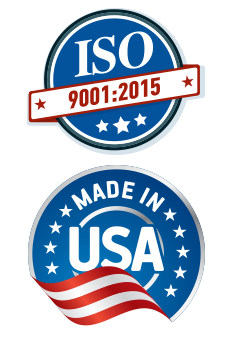PROPERTIES
Type III (hard) anodizing is an anodizing process that forms an extremely hard, abrasion resistant, porous oxide on aluminum. It is generally referred to as an “engineering hard” due to the fact that the oxide has been found to be suited for applications where the hardness and increased oxide thicknesses are an advantage.
Hard anodize, while usually done in a sulfuric acid based electrolyte, is much thicker and denser than the more conventional sulfuric anodize. Hard anodize is specified for aluminum components subject to extreme wear applications where superior abrasion resistance is needed, or corrosive environments where a thicker, harder, more durable coating is necessary. It can also be valuable where enhanced electrical insulation is required. Since hard anodize can be built up to several thousandths in some cases, it makes this type of anodize a candidate for salvaging worn or mis-machined components.
HOW IS TYPE III HARD ANODIZE DIFFERENT FROM OTHER TYPE OF ANODIZE
Type III hard anodizing differs from the typical Type II room temperature anodizing in a number of ways:
The anodizing bath parameters for Type III hard anodizing are similar to type II (room temperature) anodizing in that the acid and aluminum concentrations can be virtually the same. The difference becomes apparent when you consider the other operating parameters.
Anodizing SystemsType III anodizing is performed in a sulfuric acid bath containing 180-200 grams per Liter of acid and a small amount of dissolved aluminum. The operating temperature is controlled between 28-32º F but in some instances an acceptable oxide can be achieved at slightly higher temperatures. Current densities can range from 24-40 amps per square foot (ASF), but commonly are run at 24-30 ASF. The power supply is a DC rectifier. The aluminum part being anodized is made the anode (or positive pole) in the system. The most efficient cathodes (or negative pole) are 6063t6 aluminum.
Current is applied to the system for a prescribed time, and at the desired current density to achieve the oxide thickness required (oxide thicknesses can range from 0.7 mil to 3.0 mils). The resulting porous oxide can then be colored or sealed but limitations on final color will determined by the oxide produced and color used.
What are the attributes / characteristics of Sulfuric Acid Anodize?
- Improved wear resistance
- Non-conductive
- Can repair worn surfaces on aluminum
- Improve parts surface for slide applications
- Can be black dyed; other colors less decorative
- Finish is harder than tool steel
- Can be ground or lapped
What are the applications of Sulfuric Acid Anodize?
- Valves
- Pistons
- Sliding Parts
- Hinge Mechanisms
- Cams
- Gears
- Swivel Joints
- Insulation Plates
- Blast Shields
We provide the following services:
- ANODIZE TYPE II
- ANODIZE TYPE III
- ELECTROLESS NICKEL
- CHEM FILM
- PASSIVATION
- DRY FILM LUBE
- PAINT/POWDER COATING
- MULTI PROCESS
WELCOME TO ELITE METAL FINISHING.
We have been working with OEM’s and machine shops for the past 18 years.
The three top issues that we hear from our customers are:
- Frustration with poor quality
- Frustration with customer-centered service and assistance.
- Frustration with lack of communication when problems arise with your order
Elite Metal Finishing has helped companies such as ViaSat, Direct Aero Systems and Pentair Electronics address these problems.
WE GET IT!
Would you be interested in learning how?
Please call us or email your RFQ.
We invite you to visit our facility for a personal tour or will arrange a meeting at your facility to discuss your requirements.
We are here for you with the goal to help you solve your problems.
Sincerely,
Dan Rose
President
